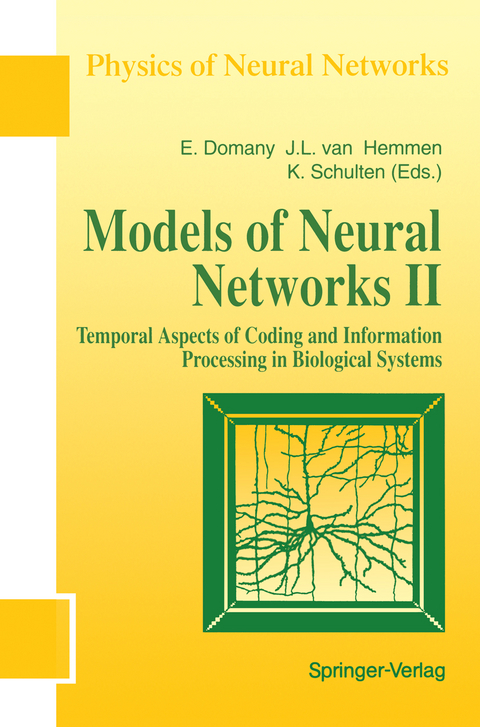
Models of Neural Networks
Springer-Verlag New York Inc.
978-1-4612-8736-0 (ISBN)
Since the appearance of Vol. 1 of Models of Neural Networks in 1991, the theory of neural nets has focused on two paradigms: information coding through coherent firing of the neurons and functional feedback. Information coding through coherent neuronal firing exploits time as a cardinal degree of freedom. This capacity of a neural network rests on the fact that the neuronal action potential is a short, say 1 ms, spike, localized in space and time. Spatial as well as temporal correlations of activity may represent different states of a network. In particular, temporal correlations of activity may express that neurons process the same "object" of, for example, a visual scene by spiking at the very same time. The traditional description of a neural network through a firing rate, the famous S-shaped curve, presupposes a wide time window of, say, at least 100 ms. It thus fails to exploit the capacity to "bind" sets of coherently firing neurons for the purpose of both scene segmentation and figure-ground segregation. Feedback is a dominant feature of the structural organization of the brain. Recurrent neural networks have been studied extensively in the physical literature, starting with the ground breaking work of John Hop field (1982).
1. Coding and Information Processing in Neural Networks.- 1.1 Description of Neural Activity.- 1.2 Oscillator Models.- 1.3 Spiking Neurons.- 1.4 A Network of Spiking Neurons.- 1.5 Hebbian Learning of Spatio-Temporal Spike Patterns.- 1.6 Summary and Conclusions.- References.- 2. The Correlation Theory of Brain Function.- Foreword.- 2.1 Introduction.- 2.2 Conventional Brain Theory.- 2.3 The Correlation Theory of Brain Function.- 2.4 Discussion.- References.- 3. Firing Rates and Well-Timed Events in the Cerebral Cortex.- 3.1 Measuring the Activity of Nerve Cells.- 3.2 Rate Functions and Stationary Point Processes.- 3.3 Rate Functions for Nonstationary Point Processes.- 3.4 Rate Functions and Singular Events.- References.- 4. The Role of Synchrony in Neocortical Processing and Synaptic Plasticity.- 4.1 Introduction.- 4.2 Pattern Processing and the Binding Problem.- 4.3 Evidence for Dynamic Interactions Between Spatially Distributed Neurons.- 4.4 Stimulus-Dependent Changes of Synchronization Probability.- 4.5 Synchronization Between Areas.- 4.6 The Synchronizing Connections.- 4.7 Experience-Dependent Modifications of Synchronizing Connections and Synchronization Probabilities.- 4.8 Correlation Between Perceptual Deficits and Response Synchronization in Strabismic Amblyopia.- 4.9 The Relation Between Synchrony and Oscillations.- 4.10 Rhythm Generating Mechanisms.- 4.11 The Duration of Coherent States.- 4.12 Synchronization and Attention.- 4.13 The Role of Synchrony in Synaptic Plasticity.- 4.14 The Role of Oscillations in Synaptic Plasticity.- 4.15 Outlook.- 4.16 Concluding Remarks.- References.- 5. Associative Binding and Segregation in a Network of Spiking Neurons.- 5.1 Introduction.- 5.2 Spike Response Model.- 5.3 Theory of Locking.- 5.4 Simulation Results.- 5.5 Application to Binding and Segmentation.- 5.6 Context Sensitive Binding in a Layered Network with Feedback.- 5.7 Discussion.- 5.8 Conclusions.- References.- 6. Modeling the Sensory Computations of the Olfactory Bulb.- 6.1 Introduction.- 6.2 Anatomical and Physiological Background.- 6.3 Modeling the Neural Oscillations in the Olfactory Bulb.- 6.4 A Model of Odor Recognition and Segmentation in the Olfactory Bulb.- 6.5 A Model of Odor Segmentation Through Odor Fluctuation Analysis.- 6.6 Discussion.- References.- 7. Detecting Coherence in Neuronal Data.- 7.1 Introduction.- 7.2 Time Resolved Detection of Coherence.- 7.3 Memory and Switching in Local Field Potentials from Cat Visual Cortex.- 7.4 A Model-Dependent Approach.- 7.5 Memory and Switching in Multiunit Activities from Cat Visual Cortex.- 7.6 Reconstruction of Synchronous Network States.- 7.7 Summary.- References.- 8. Hebbian Synaptic Plasticity: Evolution of the Contemporary Concept.- 8.1 Concept of a Hebbian Synapse.- 8.2 Experimental Evidence for Hebbian Synaptic Mechanisms.- 8.3 Biophysical Models of LTP Induction.- 8.4 Bidirectional Regulation of Synaptic Strength.- 8.5 Interaction Between Dendritic Signaling and Hebbian.- Learning.- References.- 9. Reentry and Dynamical Interactions of Cortical Networks.- 9.1 Introduction.- 9.2 Models of Cortical Integration.- 9.3 Summary and Conclusion.- References.
| Reihe/Serie | Physics of Neural Networks |
|---|---|
| Zusatzinfo | XVI, 347 p. |
| Verlagsort | New York, NY |
| Sprache | englisch |
| Maße | 155 x 235 mm |
| Themenwelt | Informatik ► Theorie / Studium ► Künstliche Intelligenz / Robotik |
| Medizin / Pharmazie ► Medizinische Fachgebiete ► Neurologie | |
| Naturwissenschaften ► Physik / Astronomie ► Angewandte Physik | |
| Naturwissenschaften ► Physik / Astronomie ► Thermodynamik | |
| Schlagworte | Neural networks |
| ISBN-10 | 1-4612-8736-7 / 1461287367 |
| ISBN-13 | 978-1-4612-8736-0 / 9781461287360 |
| Zustand | Neuware |
| Haben Sie eine Frage zum Produkt? |
aus dem Bereich


